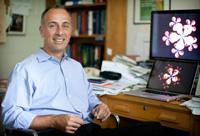Breakthrough towards quantum computing at University of Virginia
16 Jul 2011
A sort of Holy Grail for physicists and information scientists is the quantum computer.
Such a computer, operating on the highly complex principles of quantum mechanics, would be capable of performing specific calculations with capabilities far beyond even the most advanced modern supercomputers.
 |
| U.Va. physics professor Olivier Pfister (click for high-resolution image) (Photo: Dan Addison) |
It could be used for breaking computer security codes as well as for incredibly detailed, data-heavy simulations of quantum systems.
It could be used for applying precise principles of physics to understanding the minute details of the interactions of molecules in biological systems. It could also help physicists unravel some of the biggest mysteries of the workings of the universe by providing a way to possibly test quantum mechanics.
Such a computer exists in theory, but it does not exist in practicality – yet – as it would need to operate with circuitry at the scale of single atoms, which is still a daunting challenge, even to state-of-the-art experimental quantum science. To build a quantum computer, one needs to create and precisely control individual quantum memory units, called qubits, for information processing.
Qubits are similar to the regular memory "bits" in current digital computers, but far more fragile, as they are microscopic constituents of matter and extremely difficult to separate from their environment. The challenge is to increase the number of qubits to a practical-size quantum register. In particular, qubits need to be created into sets with precise, nonlocal physical correlations, called entangled states.





.webp)

























